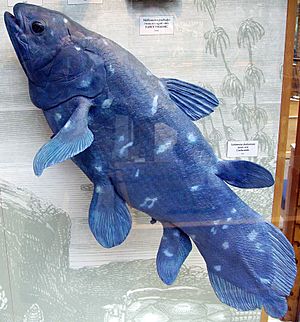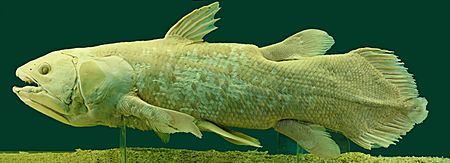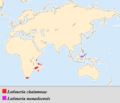West Indian Ocean coelacanth facts for kids
Quick facts for kids West Indian Ocean coelacanth |
|
|---|---|
 |
|
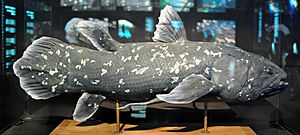 |
|
| Conservation status | |
| Scientific classification | |
| Genus: |
Latimeria
|
| Species: |
chalumnae
|
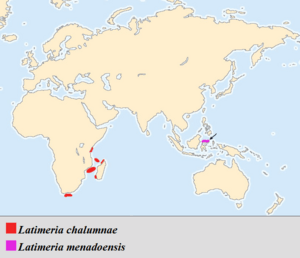 |
|
| L. chalumnae range in red | |
| Synonyms | |
|
|
The West Indian Ocean coelacanth (Latimeria chalumnae) is a very special and rare fish. It's sometimes called the gombessa or African coelacanth. This amazing creature is one of only two living types of coelacanths left in the world.
Coelacanths are more closely related to lungfish and animals with four limbs (like us!) than to most common ray-finned fishes. The other living species is the Indonesian coelacanth. The West Indian Ocean coelacanth was first found near the Comoro Islands, Madagascar, and Mozambique in the western Indian Ocean.
People once thought these fish hadn't changed much over millions of years. However, new discoveries show they had more variety in their shapes and sizes in the past. This coelacanth is famous for its bright blue color. Sadly, it is currently listed as critically endangered on the IUCN Red List, meaning it is at high risk of disappearing forever.
Contents
Body and how it works
The West Indian Ocean coelacanth is a large fish. It usually weighs about 80 kg (176 lb) and can grow up to 2 m (6.5 ft) long. Female coelacanths are usually a bit bigger than males.
These fish have a deep royal blue color with spots. This coloring helps them hide from predators and sneak up on their prey. They have very large eyes and many special cells in their eyes called rods. These help them see well in the dark waters where they live.
Like some other fish, the coelacanth has special organs such as a rectal gland, pituitary gland, pancreas, and spinal cord. To keep their body fluids balanced, they hold a substance called urea in their blood. This helps them live in saltwater.
Reproduction and life cycle
Latimeria chalumnae are ovoviviparous fish. This means they keep their eggs inside their body until the babies hatch. They don't have many babies at once because their pregnancy lasts a very long time, about 12 months. Scientists are still learning about when these fish become old enough to have their own babies.
Where they live and what they do
L. chalumnae are often found at depths between 180 and 210 m (590–690 ft). Sometimes, they can be found as deep as 243 m (797 ft). They live in underwater caves, especially lava caves, which might limit how deep they can go. These caves also protect them from predators.
During the day, coelacanths stay inside these caves. At night, they come out to hunt for food in the areas around the caves.
Some coelacanths have been seen doing "headstands" when they eat. This allows them to slurp up prey from small cracks and holes in the lava caves. They can do this because they have a unique ability among living vertebrates: they can move both their upper and lower jaws.
Population and conservation
L. chalumnae live in many places around the western Indian Ocean, but there are very few of them in each place. They are found from South Africa up the east African coast to Kenya, the Comoros, and Madagascar. They seem to live in small groups.
In 1991, it was thought that only 2 to 5 coelacanths were accidentally caught each year near Grand Comoro. This was about 1% of their population. Between 1991 and 1994, the total number of coelacanths dropped by about 30%. By 1998, it was estimated that there were 500 or fewer West Indian Ocean coelacanths left. This small number puts the species at great risk. Near Grand Comoro, an island northwest of Madagascar, there are thought to be a maximum of 370 individuals.
The IUCN lists L. chalumnae as critically endangered. This means they are very close to extinction. In 1989, the coelacanth was added to Appendix I of the Convention on International Trade of Endangered Species treaty. This treaty stops international trade of the fish for money and controls all other trade, like sending specimens to museums, through a system of special permits.
Discovery
First discovery in South Africa
On December 23, 1938, a fishing boat captain named Hendrik Goosen was returning to the harbor in East London, South Africa. He had been fishing between the Chalumna and Ncera Rivers. He often called his friend, Marjorie Courtenay-Latimer, who was the curator at the East London Museum, to see if she wanted to look at his catch for anything interesting. This time, he told her about a very strange fish he had saved for her.
Records show that Captain Goosen was very careful with this fish. He told his crew to set it aside so it wouldn't get damaged for the museum. Goosen later said that the fish was a shiny blue color when he first saw it. But by the time his boat reached the harbor many hours later, the fish had turned dark grey.
Marjorie Courtenay-Latimer couldn't find a description of the fish in any of her books. She tried to reach her friend, Professor J. L. B. Smith, but he was away for Christmas. Since she couldn't preserve the fish herself, she sadly had to send it to a taxidermist to be stuffed.
When Professor Smith returned, he immediately knew it was a coelacanth! These fish were only known from fossils, so finding a living one was an incredible discovery. Smith named the fish Latimeria chalumnae to honor Marjorie Courtenay-Latimer and the waters where it was found. Both discoverers became famous right away, and the fish became known as a "living fossil" because it was thought to be a creature from ancient times that was still alive. The 1938 coelacanth is still on display in the East London, South Africa, museum.
However, because the fish had been stuffed, its gills and skeleton couldn't be studied properly. So, there was still some doubt about whether it was truly the same species as the fossil coelacanths. Professor Smith then began a search for a second specimen, which took more than ten years.
The second specimen
A second coelacanth was caught in 1952 off the coast of Anjouan. This fish was missing its top fin and had a deformed tail fin. At first, scientists thought it was a new species and gave it a new name, Malania. It was named after the Prime Minister of South Africa at the time, Daniel François Malan, who helped make sure the fish was preserved with its muscles and internal organs mostly intact.
Types of Coelacanths
The West Indian Ocean coelacanth (Latimeria chalumnae) belongs to the group of fish called Latimeria. There is only one other species in this group: the Indonesian coelacanth (Latimeria menadoensis).
Between September 1997 and July 1998, two coelacanths were found off the coast of Manado Tua Island, Sulawesi, Indonesia. These fish were different from the Latimeria chalumnae found near the Comoros. The Indonesian coelacanth can be told apart by its grey color.
Genetics
In 2013, scientists studied the entire genome (all the genetic information) of Latimeria chalumnae. They did this to learn more about how animals with four limbs, like humans, evolved. For a long time, people thought coelacanths were the closest living relatives to the first animals that walked on land, because of some of their body features.
However, after studying their genes, scientists found that lungfish are actually the closest relatives to land animals. You can find the full genetic information about the coelacanth on the Ensembl genome browser.
Images for kids
See also
 In Spanish: Celacanto de Comoras para niños
In Spanish: Celacanto de Comoras para niños



